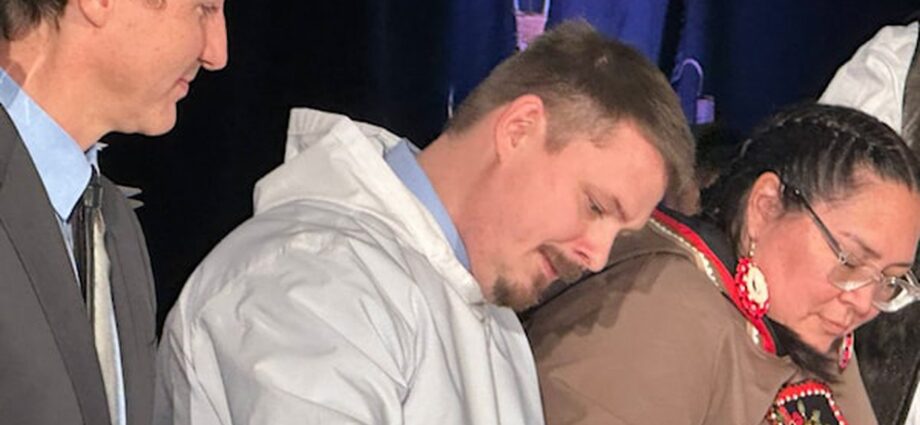
By Kira Wronska Dorward, Local Journalism Initiative Reporter, Nunavut News
January 19, 2024
There are many buzzwords and slogans flying around about the signing of the final Nunavut devolution agreement on Jan. 18: autonomy, vision, power, resources, “By Nunavut, for Nunavut,” “Our land, our future.”
These are just some of the terms that encompass the numerous themes and factors in this historic act billed as the shedding of the last vestiges of direct colonialism by a distant government in the south, promising true self-reliance for Nunavummiut. The term “Namminiqsurniq” attempts to encapsulate all these ideas, with the official translation reading as “achieving greater autonomy.”
“Nunavut devolution… it has a lot of deep meaning in terms of things like jobs, opportunities, resources, but also the political development of the territory as well,” said Pauloosie Suvega, the Government of Nunavut’s chief devolution officer. “There’s a lot that will be covered over the next [few] years, but I think what we want to focus on is ensure that everyone has a great understanding of what development will mean to them, not just to us, the three parties [GN, Nunavut Tunngavik Incorporated and the Government of Canada].”
Suvega acknowledged some points of disagreement and contention in the negotiations process since 2019 but he described a “high degree of camaraderie, partnership, and cooperation” overall.
“I think one of the biggest advantages we always have in Nunavut is that we know each other really well… we know what works up here, we know what doesn’t work up here,” he said. “A lot of us that work on [negotiations], we live in the same communities, our children go to the same schools, we know each other really well, and that often tends to be a strength… and that really drove where the conversation went at the negotiating table.”
Emphasis on Inuit workforce
A key portion of the Nunavut Agreement, outlined in Article 23, provides for representation of Inuit in the government workforce.
“We made the argument,” said Alastair Campbell, senior policy advisor for the GN, “that there had to be a focus on Inuit human resource development and training as part of the devolution process. It wasn’t enough just to transfer the responsibilities across [from the federal government to the territorial]… NTI has pursued [Inuit resource development] fairly heavily from the start of negotiations.”
In total, this means a ballpark figure of 100 civil service jobs in Nunavut, accounting for Inuit representation.
“By and large those positions will be based in Nunavut…. there’s also those that we’ll be targeting in terms of those that might not be in the workplace, maybe in the school or in post-secondary — maybe they’re working in industry. So there’s lots of different angles that we’re looking at… to see how we can engage sectors in different ways with future employees,” Campbell added.
“The human resource development strategy that has been jointly developed by the three parties that will largely guide the development of things like training, engagement, building up skills — essentially building up a community of different professionals… we’re looking at identifying individuals in different fields and see how they can take advantage of that.”
It was stated that the majority of these new positions would be situated in Iqaluit, with some located in Rankin Inlet, Cambridge Bay and, perhaps, Kuglutuk.
“The federal government is a huge supporter of the Inuit training and human resources development strategy,” said Fred Caron, chief negotiator for the Government of Canada. “As you can see, we’ve provided significant resources… we’re fully behind it, and we’re anxious to see the results start happening.”
Suvega noted that, based on previous negotiations, his team has gained “the ability to learn from their experiences and develop our own best practices.”
Housing ‘footprint of success’
Other than local control over job creation and administration, devolution will involve “housing as a huge part of this package,” according to Mark Johnson, executive director and deputy of negotiations for the Government of Canada.
Subscribe to our newsletter.
“We know there’s a crisis we’ve been in for decades,” Premier P.J. Ageeagok told Nunavut News in regards to housing. “As a government, we’ve put in a quarter of a billion dollars in the last two years to put our equity into the issue, but we really need a partner to get us to that finish line. So we’ve been lobbying and working with Ottawa to make sure that succeeds, because we know that it has a direct impact on the fabric of Nunavut. We look at the social determinants, the health determinants, the education outcomes, among many. So at the root of it is really the housing crisis we’ve been faced with. So we’ve really found a creative way to build three times more [homes] than we normally do, and we’ve lowered the cost by about 50 per cent. So we’ve really put a footprint of success down, and we’ll continue to have those conversations with Ottawa on key issues.”

